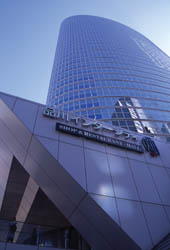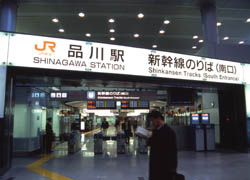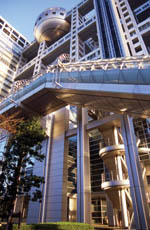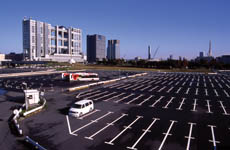Tokyo Real Estate: Revival or Risk?
Back to Contents of Issue: March 2004
|
|
|
|
by Tony McNicol |
|
|
There had been talk among economists of an impending glut of office space for a while -- the so-called "2003 problem." Many argued that the developers of these gravity-defying skyscrapers might have greater difficulty defying economic gravity. Over-supply, they contended, would push office vacancy rates in Tokyo into the double figures.
But thus far, major Japanese companies have happily ditched downtown Tokyo for hypermodern offices. Old office areas are emptying out, and even recently developed districts like Tokyo Bay are struggling to attract tenants.
The largest of the buildings near Shinagawa's new Shinkansen station is Shinagawa Intercity, home to Sony's headquarters and completed in 1998. Other buildings were opened at the beginning of this year and now house companies from the Mitsubishi Group.
The mainly office-block Shinagawa development isn't quite as fashionable as the new Roppongi Hills and Shiodome buildings, but it does have some practical advantages. Business-tripping Mitsubishi employees can now shave 15 minutes off bullet train journeys. A spokesman for Mitsubishi Motors notes the area's plethora of new bars and restaurants, and adds: "Our headquarters was getting old; we wanted a new building with better IT facilities."
The new Shinagawa bullet train station has also become entangled in a struggle for customers on the Tokyo-Osaka route, pitting JR Tokai against Japan's domestic airlines. Before the station opened, JR Tokai was reportedly expecting 70,000 travelers to use the station each day. JR Tokai says that passenger numbers were around 47,000 on average last fall. According to the Asahi Newspaper, All Nippon Airways, one of Japan's domestic carriers, has seen a 26 percent increase in passengers flying from Tokyo to Osaka. JR Tokai's campaigns seem to have merely shifted passengers from Tokyo station to Shinagawa -- the overall increase in passengers was only 3 percent.
According to Ikoma Data Service System, a real estate consultancy, office vacancy rates in the center of Tokyo were nearly 9 percent in the fall of 2003. IDSS's Takeo Maezawa says that the consultancy is "expecting a gentle improvement in the office market" in the near future. They are not expecting the dramatic increase in office supply to continue much past 2004.
Although there won't be any developments on the scale of, say, the Roppongi Hills complex, a steady supply of new buildings -- including developments in Marunouchi and Nihonbashi -- are likely to keep vacancy rates high in the near future. Even so, Maezawa suggests that by next summer the 2003 problem may well have blown over. "A lot of buildings were built," he concedes. "But the 2003 problem wasn't that much of a problem in the end."
Ikoma's office market report remarks that "local regions continue to face the problems of prolonged sluggishness of demand and high vacancy rate that is over and above the level in primary cities."
Even less central and slightly less "new" areas in Tokyo have suffered. For the Rinkai district in Tokyo Bay, inconvenient transport and high costs have put off businesses. When Odaiba was planned during the bubble economy, developers hoped that businesses would despair of exorbitant land prices in central Tokyo and move out to the reclaimed land of Tokyo Bay. When the bubble burst, attention turned back to central Tokyo and Rinkai's artificial islands were left at sea.
Tokyo Bay is now better known for sightseeing views and architecture than business. Its most famous landmarks are probably the Rainbow bridge spanning the bay and Fuji TV's headquarters in central Odaiba.
The Odaiba Bay area is served by two train lines: the slow but scenic Yurikamome monorail and the recently completed Rinkai line. Shoppers, tourists and couples can come to enjoy the sea air, views of the Tokyo skyline, a large illuminated ferris wheel, numerous malls and a recreated Edo period hot spring resort. 1.3 million visitors over the last 6 months came to see a North Korean spy ship sunk then raised by the Japanese Self-Defense Forces and displayed in the Tokyo Maritime museum.
However, even Odaiba's shops feel the pinch as newer, bigger and more fashionable developments lure shoppers elsewhere. An employee of a clothing company with a branch in Odaiba's Aquacity shopping mall told J@pan Inc that the shop's takings were down 10 to 20 percent compared to their other outlets this year. "More fashionable people used to come to Odaiba because it was the latest place to visit. Now they are going to Roppongi Hills and other places. It's just tourists and people from the countryside now. Odaiba isn't trendy anymore."
If planners ever had any ambition to create communities in Tokyo Bay, they seem to have had little success. American student Katherine Kuster lives in the Tokyo International Exchange center, a dormitory housing unit with more than 800 foreign and Japanese students. She says that Odaiba isn't all it's cracked up to be. "Everyone says that Odaiba is so exciting, but if you're here all the time, you know it's absolutely not. It reminds me of huge empty towns in the US with malls but no people on the street. I hardly see anybody here, except on the weekends."
Apart from the dormitory, a cluster of apartment blocks near Fuji TV and the developments up the line in Shiodome, few people live in Odaiba. Workers commuting into Tokyo from Rinkai sit in almost empty trains. Kuster complains that the only bars nearby are in the shopping malls, and many of those pull down their shutters soon after the shoppers head home. Some students in the dormitory also complain of the persistent nighttime noise from Japanese youths drag racing along Odaiba's wide empty roads. Others wonder why the government chose to build an "international exchange center" where residents have to travel 30 minutes or more to find any Tokyoites.
Yet the tide may eventually turn for the Tokyo Bay area. In 2007 work will start on a new plot for the government-owned Tsukiji fish market. The new market will be situated in Toyosu, a now vacant patch of reclaimed land. Unlike the private real estate developments in Roppongi and Marunochi, the government will foot the bill for new infrastructure in Toyosu, as well as for the market itself. Tokyo's fish traders are hoping to move into a new IT-equipped marketplace between 2012 and 2016.
In April 2006, the Shibaura Institute of Technology is planning to relocate one of its campuses and 4,300 students and staff to Toyosu. There are also plans to add five stops to the end of the Tokyo monorail line near Toyosu by 2005.
2003 was Tokyo's year for real estate revivals, in contrast to the hollowing out of regions outside the capital. With 2004's slightly brighter economic outlook, Japan's smaller cities, and even Tokyo's suburbs and Tokyo Bay, are hoping that a rising real estate tide really can raise all ships.
@ |
|
Note: The function "email this page" is currently not supported for this page.


 DESPITE ONGOING RECESSIONARY ECONOMICS, 2003 was a busy year for Tokyo construction firms. New office buildings seemed to pop up in the capital as fast as mushrooms on a long-neglected lawn. Roppongi Hills, Shiodome and Marunouchi all saw new office and leisure developments in the span of 12 months.
DESPITE ONGOING RECESSIONARY ECONOMICS, 2003 was a busy year for Tokyo construction firms. New office buildings seemed to pop up in the capital as fast as mushrooms on a long-neglected lawn. Roppongi Hills, Shiodome and Marunouchi all saw new office and leisure developments in the span of 12 months.
 The new addition to the Shinkansen line has shortened times for travelers departing from the west side of Tokyo. The opening of the station coincided with a cut in the ticket price for the Nozomi class of Shinkansen -- the fastest on the line. The station and surrounding development is handy for companies using the bullet train, Shinagawa's other rail links and the "Narita Express" train to Tokyo's international airport. This has made the new development attractive to major Tokyo-based firms; Shinagawa Intercity has an occupancy rate of almost 100 percent.
The new addition to the Shinkansen line has shortened times for travelers departing from the west side of Tokyo. The opening of the station coincided with a cut in the ticket price for the Nozomi class of Shinkansen -- the fastest on the line. The station and surrounding development is handy for companies using the bullet train, Shinagawa's other rail links and the "Narita Express" train to Tokyo's international airport. This has made the new development attractive to major Tokyo-based firms; Shinagawa Intercity has an occupancy rate of almost 100 percent.
 Since the late 90s, companies that spread their operations into other areas during the bubble economy have been closing their regional offices and returning to Tokyo. Companies have cut costs by concentrating operations in the capital. This could be one reason why the office market has avoided a crash despite the huge increase in supply. Good news for central Tokyo, but bad news for elsewhere. Urawa in the Tokyo suburbs now has a vacancy rate of 18.8 percent and Osaka has a vacancy rate of 10.4 percent.
Since the late 90s, companies that spread their operations into other areas during the bubble economy have been closing their regional offices and returning to Tokyo. Companies have cut costs by concentrating operations in the capital. This could be one reason why the office market has avoided a crash despite the huge increase in supply. Good news for central Tokyo, but bad news for elsewhere. Urawa in the Tokyo suburbs now has a vacancy rate of 18.8 percent and Osaka has a vacancy rate of 10.4 percent.
 Other plans for urban renewal have been given a boost by the effective shelving of a 12-year-old proposal to relocate Japan's capital. Attention is being focused on Tokyo again. The government is also planning a new body to replace the existing Urban Development Corp and Regional Development Corp. This new body would be an independent administrative unit established to revitalize Tokyo and other large cities.
Other plans for urban renewal have been given a boost by the effective shelving of a 12-year-old proposal to relocate Japan's capital. Attention is being focused on Tokyo again. The government is also planning a new body to replace the existing Urban Development Corp and Regional Development Corp. This new body would be an independent administrative unit established to revitalize Tokyo and other large cities.



